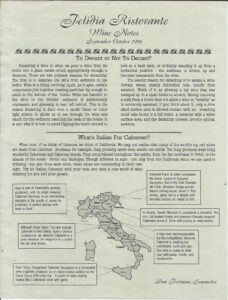Outlet Radio Network
October 22, 2004
Why Can’t You Have Both?
About 13 years ago I had the opportunity to spend an afternoon with Craig Claiborne. For those who don’t know who he was, he was probably the most influential restaurant critic who has ever written in the United States. Why? Basically, he was the first true restaurant & food critic for a major newspaper. Not that others hadn’t written about such things, but he raised it to an art form, and, he worked for the New York Times. He was also openly gay. Craig died in 2000. There’s no particular reason for this column, which was written 13 years ago, to pop up now, except it was never published, and I ran across it while I was looking through some of my files. Re-reading it brought back the memory of a wonderful afternoon earlier in my career, and I thought I’d share it here. Parts of this interview, both what’s reproduced below and more, were used by Tom McNamee in his book The Man Who Changed the Way We Eat: Craig Claiborne and the American Food Renaissance , which I’ve reviewed over on my SaltShaker blog.
, which I’ve reviewed over on my SaltShaker blog.
I’ve been picked up in a lot of places by a lot of different people, in a lot of different ways. I never expected to be picked up at a bus stop, by Craig Claiborne, in a jeep. Then again, I never expected to be picked up by Craig Claiborne. Meeting the man who made it his career to open the doors of fine food to the American public is not the sort of thing a young chef and writer gets to do every day.
Comfortably ensconced in his East Hampton, New York home, a Michael Feinstein album playing in the background, Craig Claiborne talked explicitly about his life and loves. As he is fond of pointing out, his father taught him to always tell the truth. The interview is punctuated by a brief call from his lover of eleven years, calling to make sure I’d been safely collected at the station; by preparations for lunch (we made a pot of his famed corn and crab chowder), all concentration on the task at hand; romantic recollections of intimate encounters; and moments of misty-eyed sentiment as he reminisced about the men and women he has shared his life with.
Two stints in the Navy, bartending, and public relations for ABC, led Craig Claiborne to almost three decades at the New York Times. As the food news editor, he stirred the tastes of a public that hungered for food that hadn’t been scientifically prepared by home economists. Thousands of columns and articles, and a dozen or more books, fed kitchen hints, dining tips, and food facts to millions.
Scene. A youngster sits at the Chicago World’s Fair sampling his first food outside of the south. A bowl of jellied consomme with lemon juice and tabasco.
It was the best thing I ever ate in my life.
Shift scenes. Casablanca, World War II. A young man in uniform is invited by a handsome lieutenant to have a local home-cooked meal. Couscous, coriander, cumin.
One of the most important foods I ever ate was that couscous.
Shift again. The Ile de France, an ocean voyage. A young man, now out of uniform, tenderly bites into a Turbot a l’Infante.
I took one bite and my god, I was transmogrified. I decided, I’ve got to learn how to cook French.
From there life moved swiftly. Hotel school in Lausanne, Switzerland. A couple articles for Gourmet on tea and vodka. Pushing Fluffo, a butter substitute, led to contacts at the top restaurants in town, and more importantly, with Jane Nickerson, then the food editor for The New York Times. When Jane announced her retirement, Craig’s employers took her to lunch to celebrate.
Over a nice bottle of wine, Jane described her difficulty getting away from the newspaper. She said, “everybody in town has tried. If they can scramble an egg and type with two fingers they’ve applied for this job and The New York Times has refused to take anybody.” So after a couple glasses of wine I thought, why not little old me? So I went back to the office and, if you’ll pardon the expression, I closeted myself, and wrote a note to Jane Nickerson, saying, you know all about my background, do you think The New York Times would consider hiring a man as a food writer?
Two interviews, numerous phone calls, a tense vacation on Fire Island, and the job was his.
I went back out to the beach and then I started crying, uncontrollably, saying, I said, by god, what will you ever write a column about? I saw this guy hauling in a bluefish and I said, by god, I’ll write an article about bluefish.
In thirty-three years of writing four and five columns a week, did he ever write that article?
I never wrote a column on bluefish. I don’t like bluefish.
Every writer has those moments that he or she wishes they’d had a chance to write about, opportunities that happen once in a lifetime. Any regrets?
Well, now that I’m gone [from The Times] I can think of things I’d like to do, but let me think… There were two interviews that didn’t work out… But off-hand I can’t really think of one.
He reflects a bit more and then suddenly remembers a writer’s worst nightmare. A trip through the provinces of China, hosted by the U.S. ambassador to Burma and his wife, Burt and Lily Lee Levin, and one of the top restauranteurs in China and Hong Kong, Jimmy Wu. He returned with stacks of 3 by 5 cards.
I spent three solid days writing about this trip to China, and the third morning… I pressed the wrong button. I erased the entire thing. About twenty seven pages. Gone… I couldn’t go back and rewrite, because the notes were all shuffled, I didn’t have them numbered. Gone, with the wind.
In all those weeks in China, what stood out as memorable? Two things. An awful mountain train trip from Chengdu to Chongqing in the Szechuan province, for some of the best food he had on the trip…
It was street food. Which we ate in the rain. They had marvelous, fantastic soups, and noodles, and Szechuan pickles.
and back in Chengdu…
They brought us the next little thing, about that long and that big. I pick it up with my chopsticks and I said, “what is this?” She says, “the penis [bull’s].” Well, I ate the goddamn thing, but it was so unappealing. Not because it was a penis, I’ve had enough of those in my mouth, but it was just so awful to eat.
Well, as long as the subject came up…
I’m not bragging, but I have never met someone, even a straight guy, who I haven’t been to bed with, who I couldn’t take. I mean, I don’t care how many children they have, you get anybody in the right situation, gain his confidence, and after a couple of drinks, if you’re kind, he will. That’s all.
Being gay prior to the ’80s has often been touted as a dark, furtive existence. Corporate life at ABC and The New York Times have never been noted as hotbeds of gay support. What was it like?
Everybody I’ve worked with knows I’m gay. All the people at the New York Times knows.
Did he ever find that it was a problem?
No. The funny thing is, that when my book [A Feast Made For Laughter] was published, Arthur Geld, who was the number two man at the time, it was his attitude to go into more detail about what it was like to be gay. It was never a problem.
And at ABC?
We had a boss named L. Henry. And once, after I’d been there about a year, I told L, I said, “L, you know, I’m gay.” And he shrugged his shoulders. The next day I told Dean [his roommate], and he said, “What did he do, give you a raise?”
You first came out publicly in your memoirs. Did you have any concerns about family, or “the public”?
I had a funny experience. When I was writing my memoirs, and the people I cared about, stating that I’m gay… I’ve never felt guilty about being gay, all my life. I’ve been through a lot of psychotherapy, but I can’t recall ever feeling guilty about homosexuality. And if anybody in the world wanted to know about my sexual persuasion, I’d tell them the truth. Why should I be ashamed, I didn’t ask for this… So, the only thing I cared about was my family, my niece and nephew, and my sister, I didn’t know if she cared or not. So I went down to Mississippi. We went to a restaurant. And I said, “The reason I came down, really, is to tell you that I’m writing my autobiography, and I’m going to talk about my homosexuality in it.” And so, nobody stopped eating, no dropped forks. So when I went to the men’s room, my niece turned to my sister and she said, “Did you hear what Craig said, that he’s going to tell people he’s gay?” And my sister said, “Look, my daddy always told him to tell the truth.”
Outside of being openly gay at work and in his memoirs, and socializing with friends, has he been active in the gay community?
I am not an active person. I get so tired of charities. I’m supposed to be writing the preface to an AIDS cookbook. God knows when it’ll ever come out. I wrote the preface. It’s done. I was host for a dinner, a gay dinner at God’s Love We Deliver… I got the New York Times to first cover AIDS. Larry Kramer mentioned that in his book.
Any “Life’s Most Embarrassing Moments?”
I was invited to a party at Harry Reasoner’s. A very private party. And I got drunk. And Richard Rogers was there. So, I got close to Richard Rogers, and I said, “Mr. Rogers, I’d give anything in the world just to tell somebody that you played the piano for me.” He shuffled along, he’s getting quite old, but he stood up and walked over to the piano, and I sang, with Richard Rogers playing the piano… My voice was terrible.
Forty some years of meeting chefs and restauranteurs from all over the world cannot help but leave an impression on a person. Who stands out as the most influential in Craig Claiborne’s life?
My favorite professor was Monsieur Tour. He had a great effect on me. He was a magnificent looking man, a great skier, extremely masculine. He was the head of table service… [sighs] I’m a very sentimental guy. I think Paul Bocuse [three-star chef in Lyon, France]. I just simply adore Paul Bocuse. He’s cold, a napoleon, that pose… Barry Wine [chef, The Quilted Giraffe, New York]. I love Barry. I think Pierre Franey. Because we worked together so long. Creating recipes together…
Anyone who stands out as the love of Craig Claiborne’s life?
Oh, I think my friend now. Jim. We met eleven years ago, the 3rd of July.
Favorite foods?
I have a passion for hot dogs. Once a month I sneak off and have a hot dog, with sauerkraut. I went to a restaurant called La Petite Tonkenoise [in Paris], vietnamese, and I was served the first course. I was devastated by it. It was a vietnamese spring roll, it’s called “cia gio”. I went to Saigon, in the middle of the war, just to learn to make that one dish.
What’s next on the horizon for Craig Claiborne?
Death. [laughs] That’s the only thing left for me. No, I don’t know. Well, having Jim as a friend. That’s what I live for. To be with him. We’re going to Scotland. And he’s planning a trip next year taking a European train, somewhere. But, that’s all I want. It’s an incredible experience.
As we parted ways back at the bus station, one anecdote kept running through my head.
I had a party once, a lot of TV people. And Harry Reasoner came up to me, from 60 Minutes, and said, “Craig,” he says, we’ve known each other for so many years, you are so obsessed with sex and with food, which do you prefer?” And I said, “Harry, why can’t you have both at the same time?”
I started writing food & wine columns for the Outlet Radio Network, an online radio station in December 2003. They went out of business in June 2005.





 It is tempting, for an issue on pets, to be twistedly evil and write a column on Barbecued Basset or Grilled Guinea Pig. I could perhaps even suggest some wines to pair with Neon Tetra Sushi. On the other hand, I could go the cute route and offer up some recipes for Sautéed Friskie Kibbles or Tuna-Liver Mousse for your Abyssinian.
It is tempting, for an issue on pets, to be twistedly evil and write a column on Barbecued Basset or Grilled Guinea Pig. I could perhaps even suggest some wines to pair with Neon Tetra Sushi. On the other hand, I could go the cute route and offer up some recipes for Sautéed Friskie Kibbles or Tuna-Liver Mousse for your Abyssinian.



